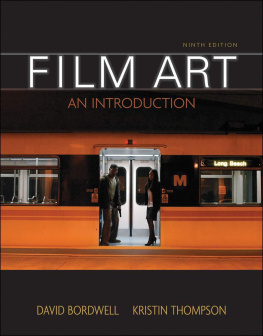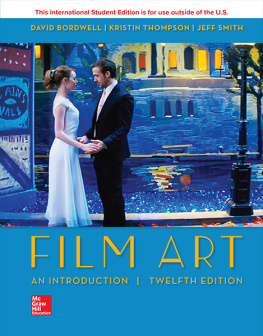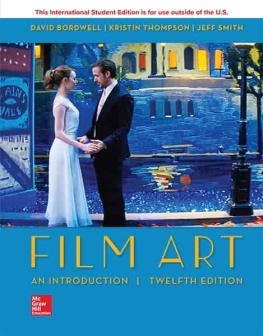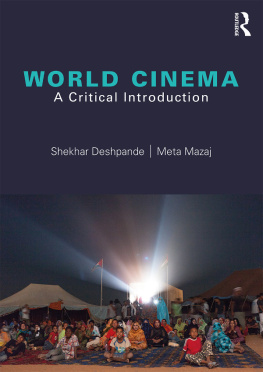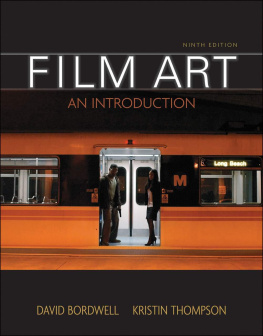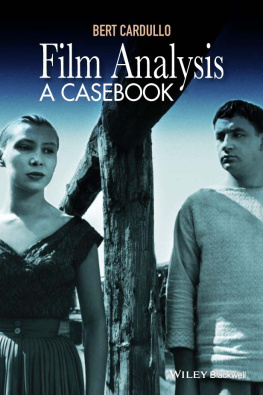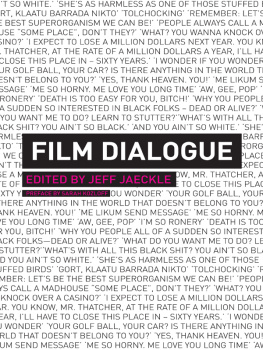FILM ART AN INTRODUCTION
NINTH EDITION
David Bordwell
Kristin Thompson
University of Wisconsin



Film Art: An Introduction
Published by McGraw-Hill, an imprint of The McGraw-Hill Companies, Inc., 1221 Avenue of the Americas, New York, NY 10020. Copyright 2010 by Hamilton Gregory. All rights reserved. No part of this publication may be reproduced or distributed in any form or by any means, or stored in a database or retrieval system, without the prior written consent of The McGraw-Hill Companies, Inc., including, but not limited to, in any network or other electronic storage or transmission, or broadcast for distance learning.
1 2 3 4 5 6 7 8 9 0 DOW/DOW 0 9
ISBN: 978-0-07-338616-4
MHID: 0-0-7338616-2
Vice President, Editorial: Michael J. Ryan
Director, Editorial: William R. Glass
Publisher: Christopher Freitag
Director of Development: Nancy Crochiere
Associate Sponsoring Editor: Betty Chen
Editorial Coordinator: Sarah Remington
Executive Marketing Manager: Pamela Cooper
Development Editor: Nadia Bidwell, Barking Dog Editorial
Senior Production Editor: Mel Valentn
Manuscript Editor: Thomas Briggs
Design Manager: Laurie Entringer
Cover and Interior Design: Jesi Lazar, BrainWorx Studio
Visual Coordinator: Sonia Brown
Media Project Manager: Thomas Brierly
Senior Production Supervisor: Tandra Jorgensen
Composition: 10.5/12 Times by Thompson Type
Printing: 45# Pub Matte, R. R. Donnelley & Sons
Cover Image: DreamWorks/Paramount/The Kobal Collection/Conner, Frank
Credits: The credits section for this book begins on and is considered an extension of the copyright page.
Library of Congress Cataloging-in-Publication Data
Bordwell, David.
Film art : an introduction / David Bordwell, Kristin Thompson.
p. cm.
Includes bibliographical references and index.
ISBN-13: 978-0-07-338616-4 (alk. paper)
ISBN-10: 0-07-338616-2 (alk. paper)
1. Motion picturesAesthetics. I. Thompson, Kristin, 1950 II. Title.
PN1995.B617 2009
791.4301dc22
2009042923
The Internet addresses listed in the text were accurate at the time of publication. The inclusion of a Web site does not indicate an endorsement by the authors or McGraw-Hill, and McGraw-Hill does not guarantee the accuracy of the information presented at these sites.
www.mhhe.com
To our parents
Marjorie and Jay Bordwell
and Jean and Roger Thompson
ABOUT THE AUTHORS
David Bordwell is Jacques Ledoux Professor Emeritus of Film Studies at the University of WisconsinMadison. He holds a masters degree and a doctorate in film from the University of Iowa. His books include The Films of Carl-Theodor Dreyer (University of California Press, 1981), Narration in the Fiction Film (University of Wisconsin Press, 1985), Ozu and the Poetics of Cinema (Princeton University Press, 1988), Making Meaning: Inference and Rhetoric in the Interpretation of Cinema (Harvard University Press, 1989), The Cinema of Eisenstein (Harvard University Press, 1993), On the History of Film Style (Harvard University Press, 1997), Planet Hong Kong: Popular Cinema and the Art of Entertainment (Harvard University Press, 2000), Figures Traced in Light: On Cinematic Staging (University of California Press, 2005), The Way Hollywood Tells It: Story and Style in Modern Movies (University of California Press, 2006), and Poetics of Cinema (Routledge, 2008). He has won a University Distinguished Teaching Award and was awarded an honorary degree by the University of Copenhagen. His website is www.davidbordwell.net .
Kristin Thompson is an Honorary Fellow at the University of WisconsinMadison. She holds a masters degree in film from the University of Iowa and a doctorate in film from the University of WisconsinMadison. She has published Eisensteins Ivan the Terrible: A Neoformalist Analysis (Princeton University Press, 1981), Exporting Entertainment: America in the World Film Market 19071934 (British Film Institute, 1985), Breaking the Glass Armor: Neoformalist Film Analysis (Princeton University Press, 1988), Wooster Proposes, Jeeves Disposes, or, Le Mot Juste (James H. Heineman, 1992), Storytelling in the New Hollywood: Understanding Classical Narrative Technique (Harvard University Press, 1999), Storytelling in Film and Television (Harvard University Press, 2003), Herr Lubitsch Goes To Holly wood: German and American Film After World War I (Amsterdam University Press, 2005), and The Frodo Franchise: The Lord of the Rings and Modern Hollywood (University of California Press, 2007). She blogs with David at www.davidbordwell.net/blog . She maintains her own blog, The Frodo Franchise, at www.kristinthompson.net/blog . In her spare time, she studies Egyptology.
The authors have also collaborated on Film History: An Introduction (McGraw-Hill, 3rd. ed., 2010) and, with Janet Staiger, on The Classical Hollywood Cinema: Film Style and Mode of Production to 1960 (Columbia University Press, 1985).
BRIEF CONTENTS
CONTENTS












PREFACE
We started to write Film Art: An Introduction in 1977, when film had just become a regular subject of study in colleges and universities. There were a few introductory film textbooks available, but they seemed to us oversimplified and lacking a clear sense of organization. After studying film since the 1960s and after teaching an introductory course at the University of Wisconsin Madison, we tried to pull together what wed learned.

